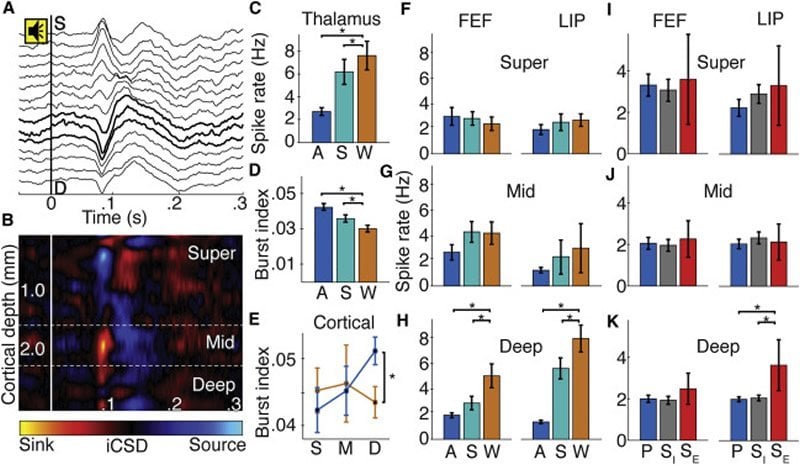Summary: Stimulating the central lateral thalamus in monkeys under anesthesia was enough to wake the animals and elicit normal waking behaviors.
Source: Cell Press
One of the central questions in neuroscience is clarifying where in the brain consciousness, which is the ability to experience internal and external sensations, arises. On February 12 in the journal Neuron, researchers report that a specific area in the brain, the central lateral thalamus, appears to play a key role. In monkeys under anesthesia, stimulating this area was enough to wake the animals and elicit normal waking behaviors.
Previous studies, including EEG and fMRI studies in humans, had suggested that certain areas of the brain, including the parietal cortex and the thalamus, appear to be involved in consciousness. “We decided to go beyond the classical approach of recording from one area at a time,” says senior author Yuri Saalmann, an assistant professor at the University of Wisconsin, Madison. “We recorded from multiple areas at the same time to see how the entire network behaves.”
The investigators used macaques as their animal model. By studying awake, sleeping, and anesthetized animals, they were able to narrow down the region of the brain involved in consciousness to a much more specific area than other studies have done. They were also able to rule out some areas that had been proposed in previous neurocorrelative studies of consciousness. They ultimately focused on the central lateral thalamus, which is found deep in the forebrain.
Once the researchers pinpointed this area, they tested what happened when the central lateral thalamus was activated while the animals were under anesthesia, stimulating the region with a frequency of 50 Hz. “We found that when we stimulated this tiny little brain area, we could wake the animals up and reinstate all the neural activity that you’d normally see in the cortex during wakefulness,” Saalmann says. “They acted just as they would if they were awake. When we switched off the stimulation, the animals went straight back to being unconscious.”
One test of wakefulness was their neural responses to oddball auditory stimulation–a series of beeps interspersed with other random sounds. The animals responded in the same way that awake animals would respond.
“Our electrodes have a very different design,” Saalmann says. “They are much more tailored to the shape of the structure in the brain we want to stimulate. They also more closely mimic the electrical activity that’s seen in a healthy, normal system.”
“The overriding motivation of this research is to help people with disorders of consciousness to live better lives,” says first author Michelle Redinbaugh, a graduate student in the Department of Psychology at the University of Wisconsin, Madison. “We have to start by understanding the minimum mechanism that is necessary or sufficient for consciousness, so that the correct part of the brain can be targeted clinically.”

“There are many exciting implications for this work,” she says. “It’s possible we may be able to use these kinds of deep-brain stimulating electrodes to bring people out of comas. Our findings may also be useful for developing new ways to monitor patients under clinical anesthesia, to make sure they are safely unconscious.”
Funding: This study was funded by the National Institutes of Health, a United States-Israel Binational Science Foundation, and a Wisconsin National Primate Research Center pilot grant.
Source:
Cell Press
Media Contacts:
Carly Britton – Cell Press
Image Source:
The image is credited to Yuri Saalmann et al.
Original Research: Open access
“Thalamus Modulates Consciousness via Layer-Specific Control of Cortex”. Yuri Saalmann et al.
Neuron doi:10.1016/j.neuron.2020.01.005.
Abstract
Thalamus Modulates Consciousness via Layer-Specific Control of Cortex
Highlights
• Central lateral thalamic stimulation arouses macaques from stable anesthesia
• Thalamic and deep-layer cortical spiking correlate with consciousness level
• Consciousness depends on feedforward, feedback, and intracolumnar signaling
• Pathway-specific signaling operates at alpha and gamma during consciousness
Summary
Functional MRI and electrophysiology studies suggest that consciousness depends on large-scale thalamocortical and corticocortical interactions. However, it is unclear how neurons in different cortical layers and circuits contribute. We simultaneously recorded from central lateral thalamus (CL) and across layers of the frontoparietal cortex in awake, sleeping, and anesthetized macaques. We found that neurons in thalamus and deep cortical layers are most sensitive to changes in consciousness level, consistent across different anesthetic agents and sleep. Deep-layer activity is sustained by interactions with CL. Consciousness also depends on deep-layer neurons providing feedback to superficial layers (not to deep layers), suggesting that long-range feedback and intracolumnar signaling are important. To show causality, we stimulated CL in anesthetized macaques and effectively restored arousal and wake-like neural processing. This effect was location and frequency specific. Our findings suggest layer-specific thalamocortical correlates of consciousness and inform how targeted deep brain stimulation can alleviate disorders of consciousness.






